- Joined
- Apr 25, 2020
- Messages
- 3,879
- Likes
- 1,249
Size comparison of ISS and the lunar gateway


 fb.watch
fb.watch
https://en.m.wikipedia.org/wiki/Edward_Makuka_Nkoloso#cite_note-bootsnall-3From 1960 until sometime after 1969, Nkoloso's "space program" sought to accomplish the launching of a rocket that would send 17-year-old Matha Mwambwa and two cats to the Moon. There were also plans for a trip to Mars.[4] Nkoloso hoped to beat the United States and Soviet Union's respective space programs at the height of the Space Race.[3]
https://en.m.wikipedia.org/wiki/Edward_Makuka_Nkoloso#cite_note-Gettysburg-10To train the astronauts, Nkoloso set up a makeshift facility on an abandoned farm 11 kilometres (7 mi) from Lusaka, where the trainees would be rolled down a rough hill in a 200-litre (55 US gal, 44 imp gal) oil drum.[4] This, according to Nkoloso, would train them in the feeling of weightlessness in both space travel and re-entry.[7][9][10] In addition, they used a tyre swing to simulate weightlessness.[4][7][10]
https://en.m.wikipedia.org/wiki/Edward_Makuka_Nkoloso#cite_note-NewYorker1-2Nkoloso stated that the goals of the program were to establish a Christian ministry to "primitive" Martians and the hope of Zambia becoming the "controllers of the seventh heaven of interstellar space". However, he reportedly instructed the missionary in the space program not to force Christianity onto native Martians.[2]
https://en.m.wikipedia.org/wiki/Edward_Makuka_Nkoloso#cite_note-FacesOfAfrica-4The rocket, named D-Kalu 1 after President Kenneth Kaunda, was a 3-metre by 2-metre (10x6 ft) drum-shaped vessel.[4][11] Nkoloso claimed that it was made of "space-worthy" aluminium and copper. The planned launch date was on Independence Day, 24 October 1964 and would take place from the Independence Stadium,[9] but the launch was purportedly denied permission due to being inappropriate.[4]
https://en.m.wikipedia.org/wiki/Edward_Makuka_Nkoloso#cite_note-Ministry-12It is said that he then asked UNESCO for a grant of £7,000,000 in Zambian pounds to support his space program.[4] It is also said he requested $1.9 billion from "private foreign sources". However, the Ministry of Power, Transport and Communication is reported as stating those requests had not been made on the behalf of Zambia.[10][12]
https://en.m.wikipedia.org/wiki/Edward_Makuka_Nkoloso#cite_note-FacesOfAfrica-4The term "Afronauts", coined by Nkoloso, refers to the participants of this program with hopes of bringing not just Zambia, but also the entire continent of Africa, to space.[4]
https://en.m.wikipedia.org/wiki/Edward_Makuka_Nkoloso#cite_note-NewYorker1-2Interviewed in 2016, President Kenneth Kaunda said of the space program that "It wasn't a real thing ... It was more for fun than anything else."[2]
Update: Further delay of ULA Vulcan first flight is highly possible.All methalox orbital launch attempts
14 Dec 2022 Land Space Zhuque-2
22 Mar 2023 Relativity Terran-1
20 Apr 2023 SpaceX Starship
July 2023 Land Space Zhuque-2 ”delayed to early July“
July 2023 ULA Vulcan Centaur "will fly when we believe it is safe to launch“
Aug 2023 SpaceX Starship "next Starship in 6-8 weeks"
View attachment 210235

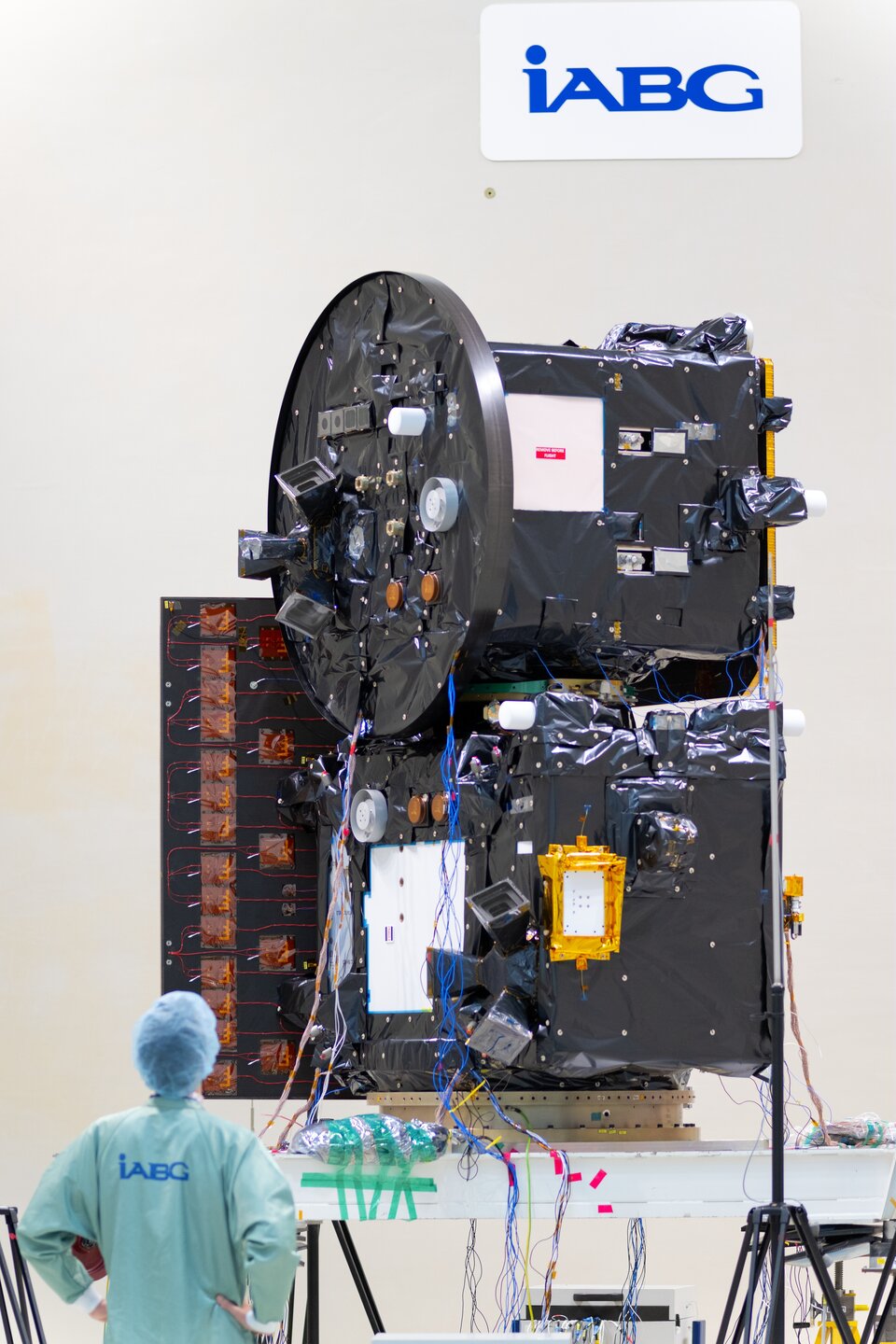 Stacked Proba-3 satellites
Stacked Proba-3 satellitesProba-3
is made up of two satellites being launched together into orbit for a single mission. The pair will fly in precise formation relative to one another to cast a sustained shadow from the disk-faced ‘Occulter’ spacecraft to the ‘Coronagraph’ spacecraft, allowing the observation of the inner layers of the Sun’s faint corona, or atmosphere, which are normally concealed by the brilliance of the solar disc.
The satellites were completed in the spring, and were then shipped to IABG for testing. IABG is one of a trio of European satellite test centres equipped with facilities to simulate every aspect of the space environment.
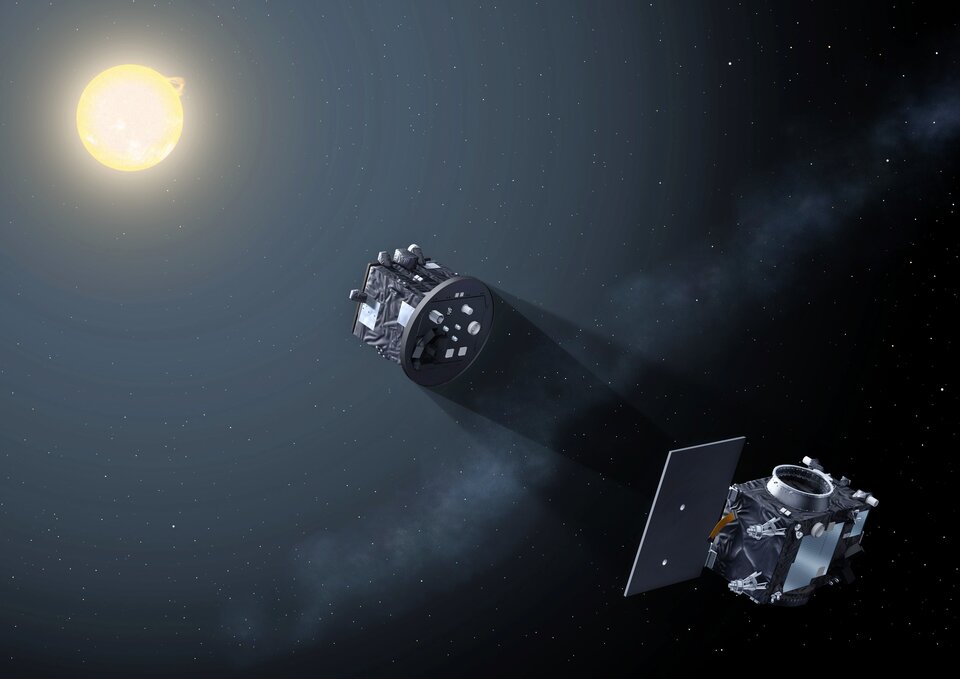 Proba-3 satellites form artificial eclipse
Proba-3 satellites form artificial eclipse“Our first priority is to be sure the pair will endure launch stresses, so once the Coronagraph spacecraft was placed on top of the Occulter spacecraft the combined stack was put through ‘sine’ testing – where we put them on a shaker table to subject them to vibrations of steadily increasing frequency to identify any resonant frequencies that might cause damage,” explains Alexandru Vargalui, Proba-3 structural engineer at ESA.
“Next came acoustic testing, where the spacecraft stack is blasted with noise levels representative of a launcher take-off.”
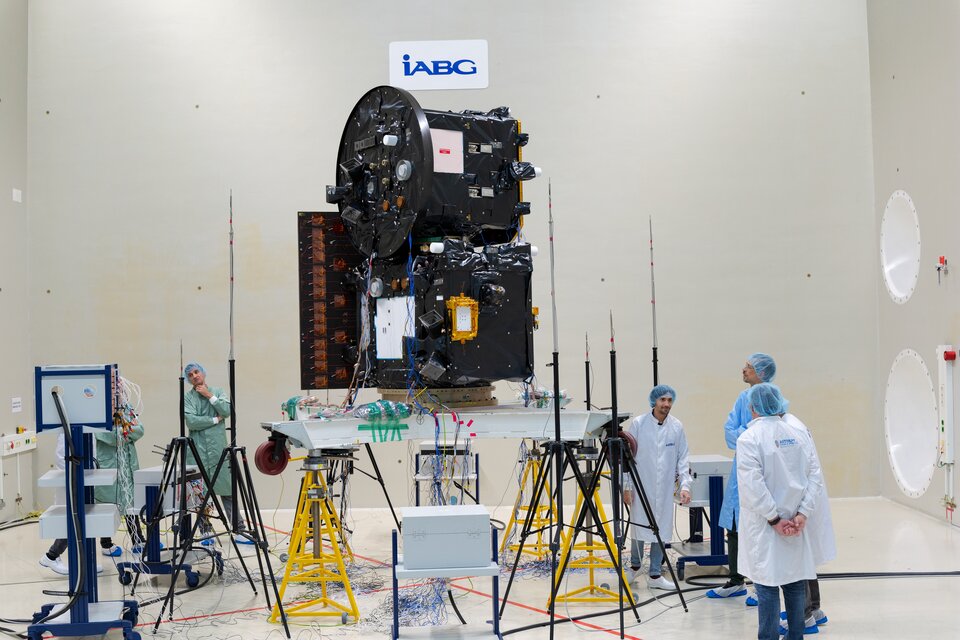 Preparing for acoustic testing
Preparing for acoustic testingHaving established Proba-3’s fitness to fly, the next step was to perform deployment mechanisms testing, trying out the systems that will separate the pair from their upper stage, and each other, as well as, crucially, the solar array drive mechanisms that will turn their solar panels towards the Sun, allowing them to charge up in orbit.
The next test stage will be one unique to this mission, explains Damien Galano, Proba-3 project manager: “For the Proba-3 pair to maintain their positions relative to each other down to millimetre-level precision, they employ a range of guidance, navigation and control systems. We are taking advantage of the large amount of space available at IABG to test Proba-3’s vision-based sensor system. This combines cameras on the Occulter spacecraft with bright LEDs on the Coronagraph spacecraft to allow them to find each other and estimate their distance apart.
 Proba-3's pair of satellites
Proba-3's pair of satellites“With this system designed to operate across up to 250 m between the two satellites, we need a wide space to test it – so we’ve previously made use of the main corridor of ESA’s ESTEC technical centre in the Netherlands.”
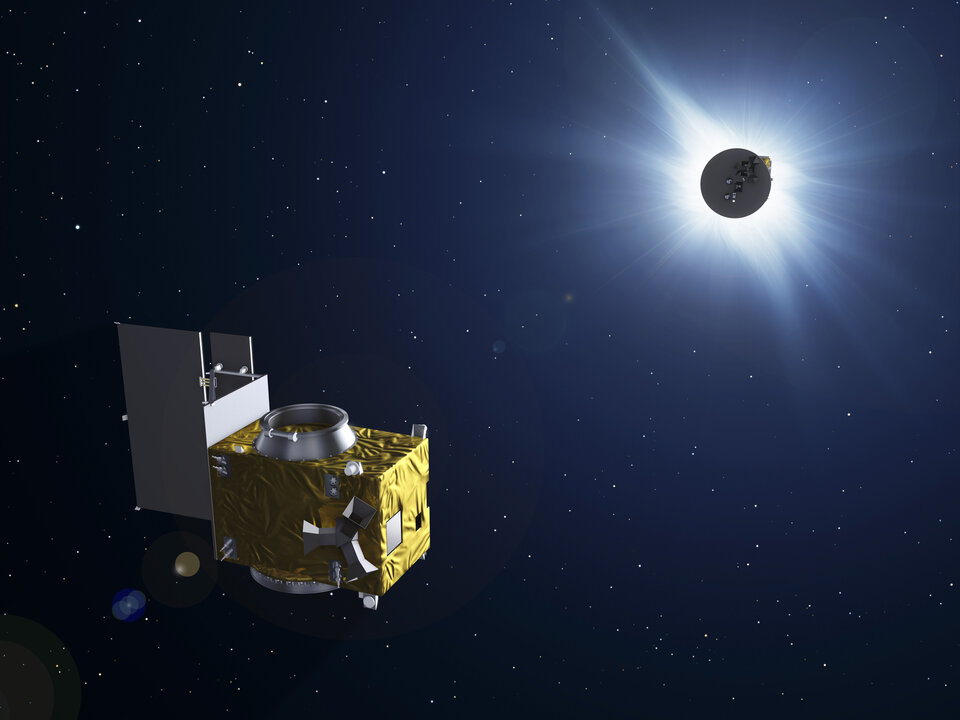 Proba-3
Proba-3Following that test, Proba-3 will undergo more traditional ‘thermal vacuum’ testing – involving the satellites being operated in space-quality vacuum for a sustained period of time while also being exposed to orbital-style temperature extremes, space being a place where it is possible to be hot and cold at the same time, if parts of your structure is illuminated by sunlight while others are in shadow.
Once the environmental campaign is complete, the satellite pair will return to Belgium to complete functional verification.
Proba-3 is due to be flown by a PSLV launcher from India next year.
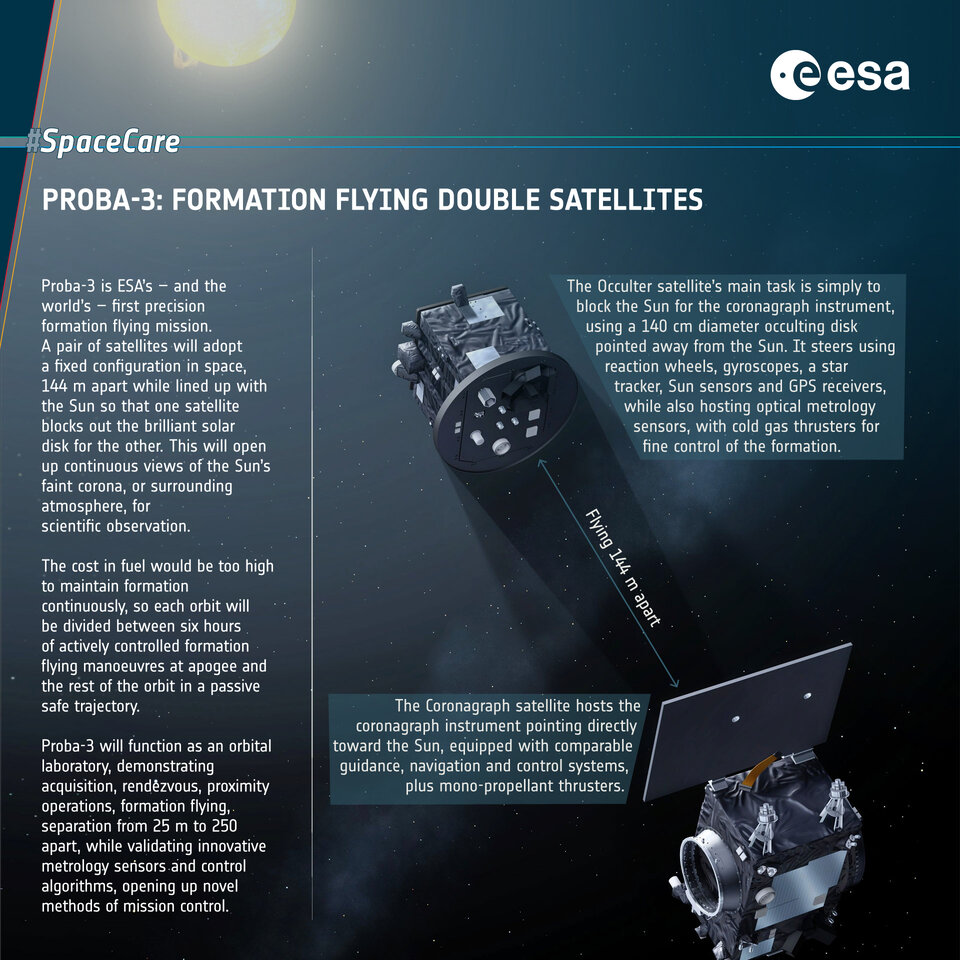 Proba-3 fact sheet
Proba-3 fact sheet
Obviously, this is part of latest attempt to bring India into USA's orbit.Nasa wants India to join US-led Artemis program
View attachment 211315
Ahead of Modi's US visit, Nasa wants India to join lunar mission | India News - Times of India
India News: Days before PM Narendra Modi’s visit to the US from June 21 to 25, Nasa officials are increasingly talking about roping in India for Nasa's Artemis Actimesofindia.indiatimes.com
Had it been so simple, Indians would have been flying on ISS long ago. There might be cooperation on Artemis but same as at levels of cooperation with France and Japan. Indian Human Spaceflight and deep space programs will remain independent in the end.Obviously, this is part of latest attempt to bring India into USA's orbit.
Stay tuned.View attachment 211318
The series of flybys have to be delicately managed in tandem with over 15,000 hours of demanding electric propulsion operations. BepiColombo made the closest approach at 19:34 UTC on June 19, 2023 or 1:04 ITC on June 20 in India. The spacecraft flew over the night side of Mercury and into the day side, with the most interesting images expected from during and after the transition.
Each of the flybys allow scientists to finetune the instruments on board the spacecraft, as well as providing a photo opportunity for Mercury. These close flybys are valuable to ensure that all the instruments on board are operating as intended when BepiColumbo eventually enters into orbit around the innermost planet and begins its science campaign.
The spacecraft has already executed an Earth flyby, two Venus flybys and three Mercury flybys. After three more Mercury flybys, BepiColombo will be able to inject itself into the orbit of Mercury on December 5, 2025. BepiColombo has entered a challenging phase of the mission that includes extended propulsion periods known as thrust arcs that can last between a few days and two months, to escape the gravitational pull of the Sun.
The distances, angles and velocities required for the spacecraft during these necessarily precise manoeuvres were all calculated years ago, before the mission even took off on the Ariane 5 rocket from Europe’s spaceport at Kourou, in October 2018. Out of an abundance of precaution, the engineers tweaked the flyby and conducted it at an increased altitude, to reduce the risk of losing the spacecraft.
The first images from the flyby are expected to be beamed back to the Earth on June 20. The images are expected to reveal tectonic features, craters and ancient volcanic flows on the surface.
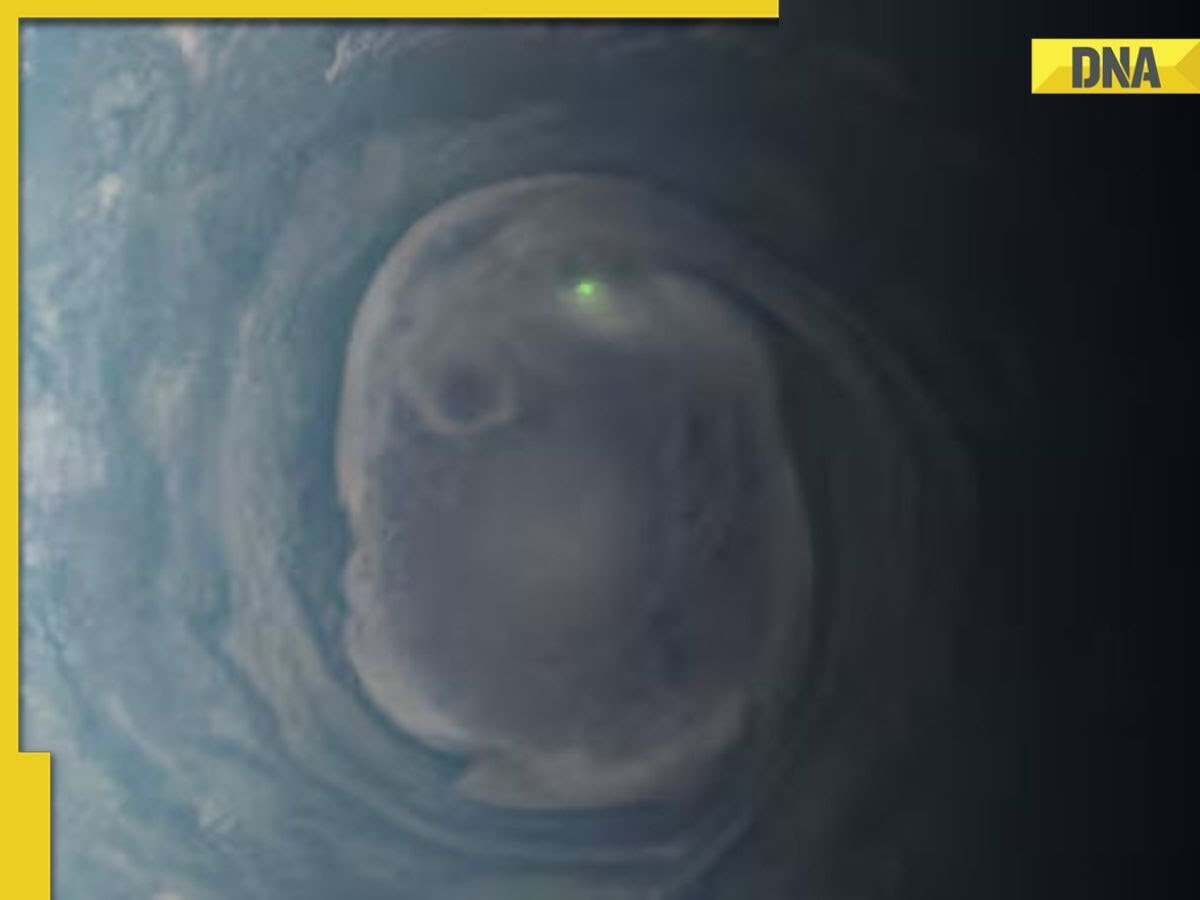
NASA's Juno spacecraft recently captured a shot of a greenish glow from a lightning strike inside a swirling vortex near the planet's north pole. The image was taken 19,900 miles (32,000 kilometres) above the planet's cloud top.
This image will likely help scientists to understand how massive storms and lightning and lightning-like events occur on the gas giant.
"Juno captured this view as Juno completed its 31st close flyby of Jupiter on Dec. 30, 2020. At the time the raw image was taken, Juno was about 19,900 miles (32,000 kilometres) above Jupiter’s cloud tops, at a latitude of about 78 degrees as it approached the planet," NASA said in a statement.
Lightning in planets of solar systemWhile lightning on Earth is formed by water clouds and mostly occurs near the equator. But on Jupiter, the strikes emerge from the clouds made up of ammonia and water. They mostly occur near the poles of the planet.
Lightning has been observed on other gas planets of the solar system - Saturn, Uranus and Neptune. Scientists have some evidence of lightning in the clouds of the planet Venus, however, it is still an issue of debate.
Juno's future endeavoursVarious studies have detailed similarities in the lightning processes on Earth and Jupiter. For instance, lightning rates on both planets are similar although the distribution of lightning on the giant planet differs from that of Earth.
Juno, which has been roaming near Jupiter since 2016 has already completed more than 50 flybys and made close passes by three of the planet's largest moons. The scientists associated with the spacecraft say they will be unearthing more fascinating discoveries in the coming months as the mission gets much closer to Jupiter's surface.
“Our upcoming flybys in July and October will bring us even closer, leading up to our twin flyby encounters with Io in December of this year and February of next year, when we fly within 1,500 kilometres of its surface,” Scott Bolton, Juno principal investigator was quoted as saying by CNN.
Notably, Juno's orbit around Jupiter is shifting closer over time, allowing scientists more opportunities to keep a close eye on the planet. The spacecraft is expected to go between some of Jupiter's rings as well which will help learn more about their origin and composition.
Japan has big plan to land the first Asian on the Moon by this decade.Had it been so simple, Indians would have been flying on ISS long ago. There might be cooperation on Artemis but same as at levels of cooperation with France and Japan. Indian Human Spaceflight and deep space programs will remain independent in the end.
Japanese program will be either be indefinitely delayed or cancelled just as what's been happening to their human spaceflight and moon missions.Japan has big plan to land the first Asian on the Moon by this decade.View attachment 211334
The government plans to land a Japanese astronaut on the moon in the second half of the 2020s who would become the first non-American to reach the surface of Earth’s natural satellite.
Stay tuned.View attachment 211335

Euclid will conduct observations over one-third of the skyThe European Space Agency (ESA) is set to launch the Euclid mission on July 1, as per the current schedule.The space telescope will provide insights into unexplored parts of the cosmos, specifically dark energy and dark matter. Both these entities are invisible and have been studied based on their effect on stars and galaxies.Here we discuss key facts of the mission.
Euclid will share its location with James Webb Space TelescopeEuclid will create the largest, most accurate 3D map of the universe, per ESA. It will observe over one-third of the sky, looking into the past 10 billion years of cosmic history. Astronomers hope to better understand dark energy and dark matter based on the mission. Dark energy plays a role in the expansion of the universe, while dark matter holds galaxies in place.
It can produce four times sharper images than ground-based surveysThe Euclid spacecraft will be positioned at the L2 Lagrange point, which lies about 1.6 million kilometers from Earth. It shares the location with several other spacecraft including the James Webb Space Telescope. From its vantage point, where the Earth, Moon, and the Sun always lie behind the spacecraft, Euclid would get unprecedented views of the vast cosmos.
The Euclid spacecraft measures about 2,100kgOver the course of the mission, Euclid will survey 5,000 square degrees of sky. The mission will perform investigations in what's called a "step and stare" mode, wherein it will focus and measure roughly 0.5 square degrees of the sky at a time.The mission will be capable of producing four times sharper images compared to ground-based surveys.
The mission is expected to operate for about six yearsIn terms of size, Euclid is considerably smaller than the James Webb telescope. The spacecraft measures about 2,100kg, 14.7 feet in height, and 10.2 feet in width. The mission will be equipped with two main instruments to perform science investigations, namely a visible imager (VIS), and the Near-Infrared Spectrometer and Photometer (NISP). The latter will provide near-infrared photometry of galaxies.
The Euclid mission will take off aboard a SpaceX Falcon 9 rocket from Cape Canaveral in Florida on July 1.It will take roughly 30 days for the spacecraft to reach its target destination, the L2 point.The mission is expected to operate for at least six years. The estimated cost of the mission is said to be €1 billion.
Obviously, this is part of latest attempt to bring India into USA's orbit.
Stay tuned.View attachment 211318
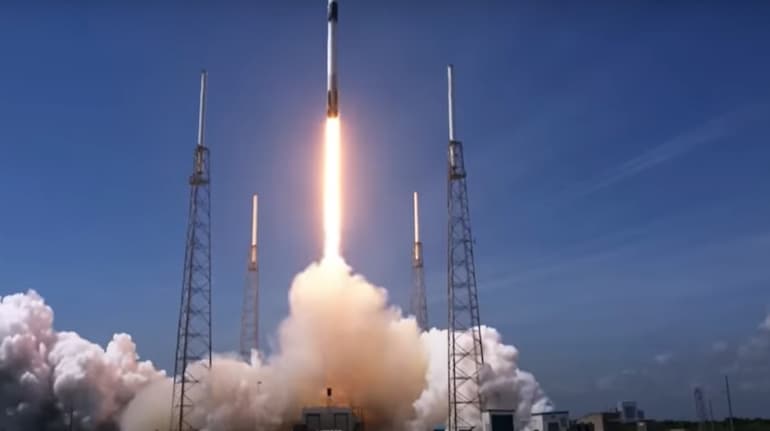
The European Space Agency (ESA) successfully launched the Euclid telescope from Cape Canaveral Space Force Station in Florida, USA, aboard a SpaceX Falcon 9 rocket, on July 1, at 17:12 CEST (8:30 pm IST) to probe the dark Universe.
The ESA's European Space Operations Centre (ESOC) in Darmstadt, Germany, confirmed the successful acquisition of the signal from Euclid after the telescope was launched and separated from the rocket. This confirmation happened at 17:57 CEST.
